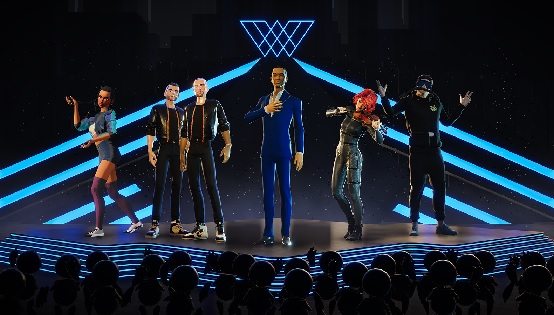
Virtual Concerts
It was a typical Saturday night in 2021. COVID-19 was in full swing, and the biggest boy band had canceled their global tour, leaving millions of fans devastated.
Nevertheless, the party should not stop and it surely did not when the same boyband released their virtual concert schedule.
So, While others were busy throwing pity parties, I was preparing to attend their concert – a virtual one.
This concert would cost me less than $100: no elaborate costumes, props, plane tickets, or hotel bookings required. My living room would become the concert hall, with my family as the audience.
As a fan living in a different country, attending a concert by your favorite band can become a financial burden that most of us cannot even consider. However, with virtual concerts, the true spirit of music can be revived without charging hefty ticket fees from the fans.
Will virtual concerts change the future of the music industry, or is it time to rethink things before profit margins drop too low for sustainability? Keep reading to find out.
Virtual Concerts – The Need of the Hour
Attending a concert is no longer limited to buying tickets. It has become a rat race of sourcing vouchers and trading tickets on the black market. People take loans, save for years, and borrow money from friends just to see their favorite singers in action.
This high ticket fee and overall cost suck the pleasure out of the concert experience.
As a universal language, music has become one of the most significant imported commodities of recent times. It churns billions of dollars in revenue. Countries train, sponsor, and recruit artists as ambassadors to promote their soft image, culture, and tourism.
In a world where thumbs do the talking, celebrities are becoming false gods we worship daily. So, the concerts have turned into rituals and pilgrimages. For fans, it is a once-in-a-lifetime opportunity, a bucket list item that earns them bragging rights.
While this may seem like a mental health investment, it can turn into a financial disaster as well. With virtual concerts, this issue can be resolved. Fans can now enjoy music without bearing the financial burden.
Moreover, artists and production companies can earn more with a single performance without investing heavily in the venue and arrangement. While it may seem like a win-win situation, there are many cons in this situation as well.
Let’s look at the overall evolution of virtual concerts along with the pros and cons list for better understanding.
The Evolution of Virtual Concerts
Virtual concerts started long before the term became popular. This might sound confusing so let us get into it.
Before virtual concerts, concert streaming was quite common. Fans would bring their cameras, phones, and other recording devices to the concerts. It started as a way to reminiscing the good memories. But over the years, the internet changed this completely.
Post the concert, the attendees would share their concert videos on streaming platforms like YouTube. In the early times of YouTube, this content was considered a Point of View(POV), so there was no copyright breach involved. You can find older vlogs of YouTube stars filled with these concerts.
Later, Wi-Fi access and cellular data made live streaming popular. Fans would bring their phones to concerts and stream the performances of their favorite stars in real time. It started as an innocent way of sharing the performance with fellow fans. Later, it turned into a way of generating money via streaming.
This gave rise to streaming cults, which made private subscription-based groups for exclusive content streaming popular. Moreover, fans would share this content on streaming platforms like Twitch, YouTube, Facebook, etc.
While it helped fans to enjoy content for a fraction of the actual money, it was harming the stars. To address this, streaming channels cracked down on content rights. Big video-sharing platforms like YouTube initiated the demonetizing process via copy strike method and sound detection.
This gave rise to exclusive streaming rights. Eventually, music companies had to fight for online music streaming rights, live performance streaming rights, and album rights separately.
During the pandemic, when everything was locked down, people embraced virtual concerts. These concerts were nothing like the pixilated, bad quality, shaky videos and bad angles that viewers experienced with streamers. It was “virtual” in the true sense.
Within these virtual concerts, fans from around the world were offered an opportunity to enjoy exclusive performances. Fans could ask questions, interact with their favorite artists, and scream their chants. Advanced technology was used to make these performances worth the money.
This technology offered crisp images, clear voice, and virtual collaboration with other artists. Visual artists, CGI professionals, and 3-D effects specialists were recruited to make this possible. Today, this has become a common practice. Most of the virtual tours use immersive concert experiences along with exceptionally appealing visuals.
K-pop initially popularized virtual concerts but now it has become a global phenomenon. Entertainment companies have designated virtual streaming platforms; they offer exclusive membership programs to these platforms.
After a successful home run during COVID, virtual concerts have become popular among international fans because of limited accessibility. Local entertainment companies sell VR concert rights to international companies so fans can enjoy the same experience for just a few bucks.
What started as an alternative way to stay entrained in quarantine has now become the dominant way to keep people entrained.
Virtual Concerts – Pros
- Price Control
One of the biggest issues right now in the entertainment industry is dynamic pricing. As the demand for concert tickets increases, the price increases as well. This creates a sense of urgency that eventually contributes to the overall price hike.
Virtual concerts will help in controlling dynamic pricing. This is especially important for people who cannot afford to buy concert tickets or spend on miscellaneous expenses. Apart from this, international fans living in countries with weaker currencies can especially benefit from virtual concerts.
- Catering Foreign Fans
Music is recognized as a universal language. People hum to the tunes, jam, and vibe without thinking about its origin and language. This makes art and artists a universal commodity. Celebrities are loved globally and fans are ready to spend millions on getting just a glimpse of their favorite stars.
However, artists always have hometown privileges. They perform better in their countries as they have access to better equipment, bigger venues, and advanced technology, and have a better understanding of rules and regulations. This is where majority of the international fans feel excluded.
For instance, K-pop is universally famous and has a global fan following. Even with such a high international following, they generally play at Asian venues, leaving the majority of the international fans disappointed. With virtual concerts, this issue can be addressed right away.
- Monetization Opportunities
Currently, music companies have limited monetization opportunities, which creates a profit-driven environment and puts Record labels in control. They buy exclusive streaming rights and decide on playing venues for the artists.
Since the playing venues and streaming opportunities are kept limited, for the sake of exclusivity, companies milk this opportunity by increasing ticket and album prices. There is no doubt that high prices offer a sense of exclusivity and achievement for the fans who are able to bag the tickets, but it leaves fans distressed.
Virtual concert tickets can help in price control and accessibility. Although virtual concerts are relatively cheaper, the collective profit of virtual concert events can contribute significant revenue.
- Flexibility
Most of us feel bored when we have nothing to do. This can be in the middle of the night, on a rainy day, or while spending a holiday season without family. When boredom hits unexpectedly, you crave a source of entrainment the most.
However, live concerts put a time stamp on the entertainment. People from all over the world clear their calendars in advance, and book tickets and hotels just to attend concerts. The influx of people from around the globe contributes to significant traffic congestion, especially on concert days.
Virtual concerts lift the time sensitivity bracket from these exclusive events. Fans get access to virtual concert portals where they can log in anytime when they get bored, from the comfort of their home.
Virtual Concerts – Cons
- Technical Challenges
Virtual concerts are all about advanced technology. However, technology is unreliable. Poor internet connection, video glitches, audio issues, software compatibility, or even recording issues can hinder the smooth flow of virtual events.
Now, as the technology is improving, expectations of fans have skyrocketed. They look for virtual concerts that offer more than just singing videos. They want immersive experiences where they can enjoy 3D imagery, holographs, and advanced CGI effects.
Moreover, they want perfectly timed and curated events where the audience does not have to wait for artists. To meet the expectations of these fans, organizers have to be tech-savvy. From working on the experience to making every part of the event memorable, organizers need to be more vigilant.
- Limited Interaction
Getting a glance at their favorite star, getting something signed; singing their hearts out, or holding a fun placard, music enthusiasts do all sorts of things to interact with their favorite singers. Some even go to great lengths just to get some attention from their favorite artists.
Interaction opportunities are not just limited to the fan-artists interaction; instead, fans also get to interact with each other. There are heartwarming videos of fans replacing opening acts by singing live. These fan-to-fan interactions are nearly impossible in a virtual setting.
However, no matter how immersive the experience the virtual concerts offer, it can never equate to real-life interaction. Most fans prefer live concerts to virtual concerts just because they get to interact with artists and fellow fans.
- Feeling Special
People who enjoy the big screen and watching movies in the cinema might like the idea of virtual concerts, but it’s not for everyone. Most people feel it’s just like watching concerts on a big screen. To address this, organizers are trying to offer an immersive experience with a virtual experience.
Fans can interact with objects, move things around, and enjoy 8D sound and 3D interactions during these concerts. Even with all these features, fans do not feel particularly special. Behavioral experts suggest that the sense of feeling special is often associated with spending a lot of money.
With live concerts, fans get to prepare in advance, spend a significant amount of money, and wait for the event. Eventually, they get to brag about attending these events. On the contrary, virtual concerts prioritize comfort zones. So, fans do not experience the same connection with the artist.
- No Collective Memory
The collective memory of an event creates a sense of belonging among people. This phenomenon fuels the rise of fandoms and record labels feed on this popularity. Fandoms like Swifties, BTS Army, Carats, and Directioners are some incredible examples of this phenomenon.
Fans prepare and attend live concerts together for the sake of experience. Fans get to interact with each other and then discuss the details with fellow fans. Since virtual concerts are happening in your living room, there is no collective memory to share.
Organizers are currently trying to enhance virtual concerts to offer a more realistic experience. Yet, technology has a long way to go before it gets on the same level as reality. When this tech advancement will happen? We can only take a guess.






